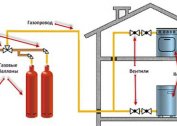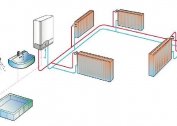Any heating system consists of pipes and radiators. Often with the advent of the heating season, we are faced with the appearance of leaks in the pipes, as well as at the places where the pipes are attached to the batteries. Of course, it is possible to eliminate the malfunction by calling a specialist, but often there are emergency cases when it is difficult to do this or it is necessary to fix the malfunction immediately.
Option 1
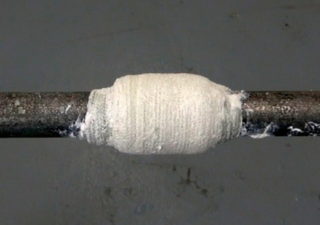 The simplest and fastest way to eliminate a leak in a pipe is to use improvised materials, namely a bandage and paint. This method can be used only in cases where the flow is insignificant (just a little oozing water).
The simplest and fastest way to eliminate a leak in a pipe is to use improvised materials, namely a bandage and paint. This method can be used only in cases where the flow is insignificant (just a little oozing water).
To do this, the leakage site is tightly tied with a bandage and smeared with oil paint. However, this method may not always help. As an alternative to paint, you can use a cement mortar, which is diluted to a liquid state.
Option 2
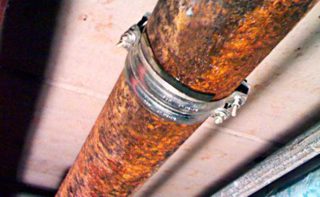 Again, the popular method of repair using rubber. In this case, the place is tightly wrapped with a piece of rubber, which is crimped by wire. At the same time, it is recommended, instead of wire, to use special metal clamps (preferably several).
Again, the popular method of repair using rubber. In this case, the place is tightly wrapped with a piece of rubber, which is crimped by wire. At the same time, it is recommended, instead of wire, to use special metal clamps (preferably several).
The clamps are mounted on top of the rubber, including one of them can be tightened directly at the place of leakage (if the surface is flat).
Option 3
If the pipe is exhausted in a place where there are no junctions and connections, the simplest and most effective option is to use a factory clamp, which can be bought at any hardware store. The principle of its operation is very simple: the product is simply laid on top of the pipe, and the bolts are clamped with a screwdriver.
Option 4
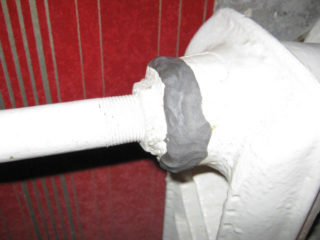 An alternative and quite effective method of troubleshooting a water supply problem is the use of cold welding - a special composition that can also be purchased at any hardware store.
An alternative and quite effective method of troubleshooting a water supply problem is the use of cold welding - a special composition that can also be purchased at any hardware store.
Liquid welding is one- and two-component. There is no significant difference in them. If you use a two-component, the composition must be thoroughly mixed until a homogeneous mass is formed. Before coating with liquid welding, the pipe or the place adjacent to the radiator must be carefully cleaned from the formed rust.
As utility tools, you can use a simple knife or a small emery cloth. Cold welding should be applied directly at the site of leakage. In this case, the composition must be strongly pressed, and after application, hold for about 20 minutes.
Option 5
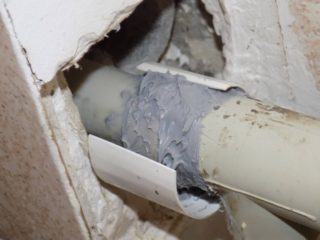 If during the inspection of the place of leakage of the pipe it is established that the cause of the leak is a leak in the place of connection of the pipe to, for example, a valve or battery, the malfunction is eliminated by repacking the connections.
If during the inspection of the place of leakage of the pipe it is established that the cause of the leak is a leak in the place of connection of the pipe to, for example, a valve or battery, the malfunction is eliminated by repacking the connections.
To do this, turn off the water. Further, using keys (for example, gas), the connection is carefully unscrewed by unscrewing the clamping sleeves. If it is not possible to untwist the joints, you can heat the problematic surface with a gas burner (also available at a hardware store).
When using open fire, it is first necessary to take care to prevent the possible ignition of wooden structures and wallpaper.
After the leakage site has been disassembled, it is necessary to clean the metal surface and then thread it with a sealing material (tow with silicone or a special thread). Next, we assemble by clamping the couplings.
General recommendations
It should be remembered that in each of the listed options, if possible, it is necessary to take preliminary measures to shut off the tap that supplies water to the heating system.
Also, do not forget about prevention. The heating system in your house will last as long as possible, if during its installation you take care of protecting the joints from corrosion. So, after mounting pipes and radiators, the metal must be coated with a primer. After drying, oil paint is applied.
If during the operation the places of rust manifestation are identified, the area must be cleaned again to metal, and then repeat the painting procedure.
At present, it is recommended, when installing the heating system, to use not metal, but polypropylene pipes, which are mounted by soldering. This type of material is not subject to corrosion, and, if necessary, you can replace the site or insert an additional radiator by cutting the chain and soldering the necessary elements.
Any of the listed troubleshooting methods in the heating system is a temporary solution. Sooner or later, the leakage site will need to be replaced by contacting qualified specialists.
